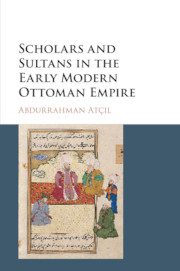Book contents
- Frontmatter
- Dedication
- Contents
- List of Tables
- Notes on Usage
- Acknowledgments
- Introduction
- Part I Scholars during the Early Ottoman Period (1300–1453)
- Part II The Formation of the Hierarchy (1453–1530)
- Part III The Consolidation of the Hierarchy (1530–1600)
- 6 The Focus of Attention Changes
- 7 The Ascendance of Dignitary Scholar-Bureaucrats (Mevali)
- 8 The Growth and Extension of the Hierarchy
- 9 The Rules and Patterns of Differentiation among Scholar-Bureaucrats
- 10 The Integration of Scholar-Bureaucrats in Multiple Career Tracks
- Conclusion
- Glossary
- Bibliography
- Index
10 - The Integration of Scholar-Bureaucrats in Multiple Career Tracks
from Part III - The Consolidation of the Hierarchy (1530–1600)
Published online by Cambridge University Press: 24 November 2016
- Frontmatter
- Dedication
- Contents
- List of Tables
- Notes on Usage
- Acknowledgments
- Introduction
- Part I Scholars during the Early Ottoman Period (1300–1453)
- Part II The Formation of the Hierarchy (1453–1530)
- Part III The Consolidation of the Hierarchy (1530–1600)
- 6 The Focus of Attention Changes
- 7 The Ascendance of Dignitary Scholar-Bureaucrats (Mevali)
- 8 The Growth and Extension of the Hierarchy
- 9 The Rules and Patterns of Differentiation among Scholar-Bureaucrats
- 10 The Integration of Scholar-Bureaucrats in Multiple Career Tracks
- Conclusion
- Glossary
- Bibliography
- Index
Summary
In Chapters 8 and 9, I discussed aspects of the stratification of scholarly positions as well as the differentiation of the scholar-bureaucrats who filled them. It was not the case, however, that scholar-bureaucrats and positions were catalogued in two separate columns in descending order according to rank and prestige and that people and offices of the same level were matched. As mentioned several times in the preceding chapters, different career paths existed within the official hierarchy. The central government probably supported the growing distinction between these different career paths, for the variety of career paths contributed to the diversification of scholar-bureaucrats in terms of talent, expertise, and level of involvement, allowing the government to assign them to tasks of various nature and levels.
Scholar-bureaucrats calculated their own skills, connections, and chances for professional progress and economic gain in the hierarchy and attempted to make the optimal decision. Some opted for immediate financial gain, while others aimed to obtain the highest positions in the long run, relinquishing higher income for a time. In some cases, they miscalculated the match between their resources and chances of advancement and had to change paths because they encountered serious obstacles to their progress. As such, scholar-bureaucrats were differentiated in terms of their career paths, their involvement in the Ottoman administration and their satisfaction.
Generally speaking, there were two broad avenues in the official hierarchy: the career track of dignitaries (mevali) and that of town judges (kasabat kadıs). It is possible to identify four different paths that led to, or were lanes within, these two broad avenues: (1) judgeships only, without the status of dignitary, (2) professorships followed by judgeships but with no status of dignitary, (3) the lower career track of dignitaries: professorships followed by judgeships with the status of dignitary but the loss of the chance to reach the top, and (4) the upper career track of dignitaries: professorships followed by judgeships with the status of dignitary and the opportunity to reach the hierarchy's upper echelons.
- Type
- Chapter
- Information
- Scholars and Sultans in the Early Modern Ottoman Empire , pp. 188 - 211Publisher: Cambridge University PressPrint publication year: 2016



